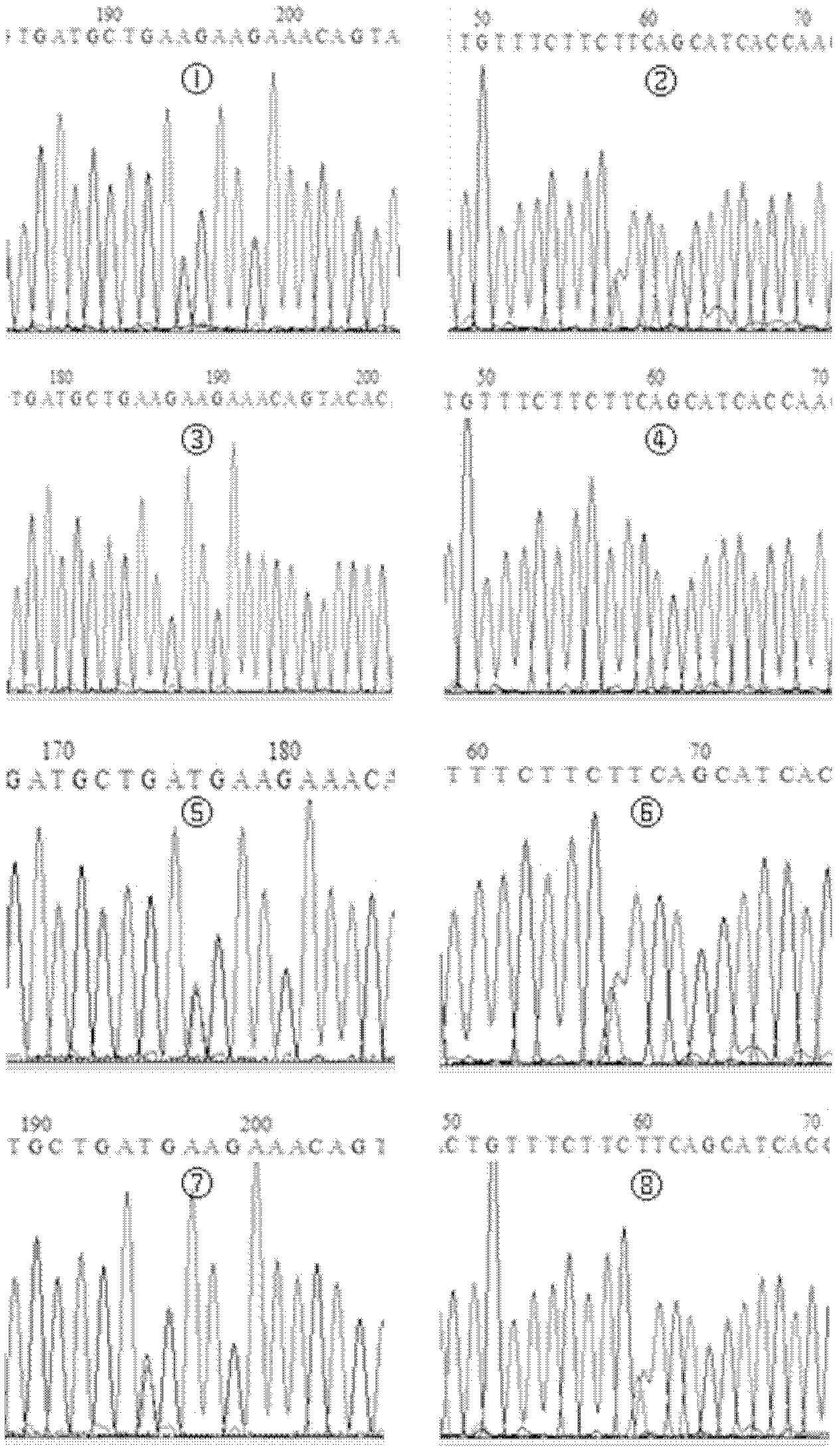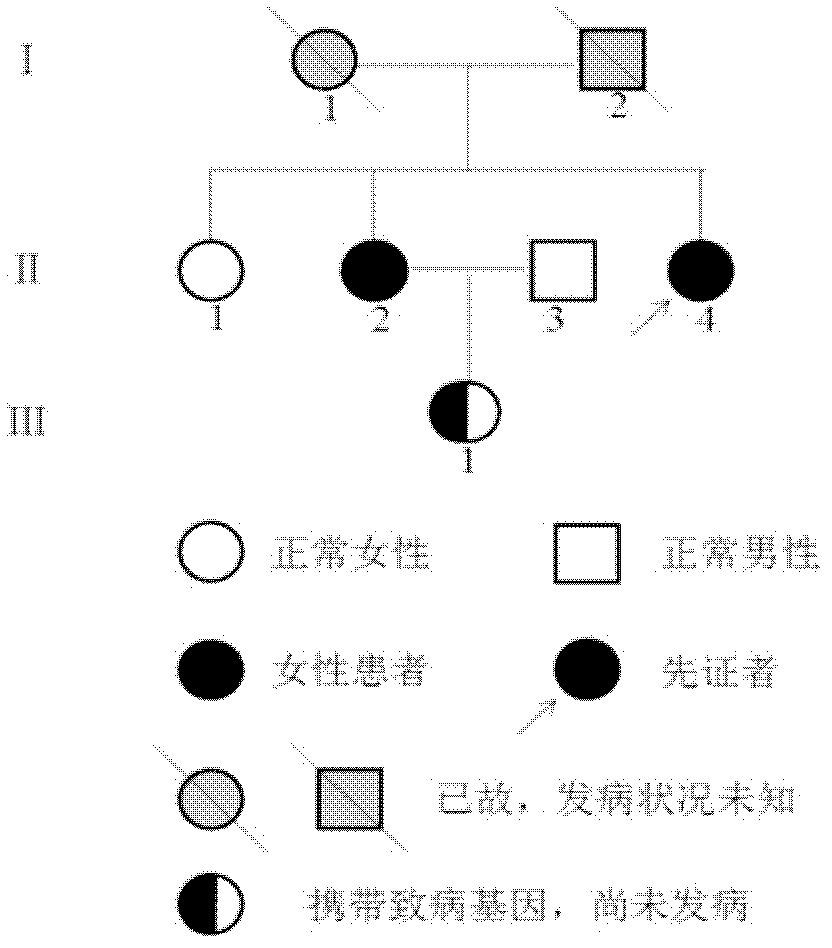Alzheimer disease pathogenic gene and application thereof
A technology for Alzheimer's disease and pathogenic genes, which can be applied in the field of molecular pathology and can solve problems such as increased levels
- Summary
- Abstract
- Description
- Claims
- Application Information
AI Technical Summary
Problems solved by technology
Method used
Image
Examples
Embodiment 1
[0041] Example 1 Verification of the relationship between Alzheimer's disease-causing genes and AD pathogenesis
[0042] The inventor collected samples from patients with AD and FTD and their relatives, see Table 1 for details.
[0043] Table 1 Collection of AD samples
[0044]
[0045]
[0046] The Alzheimer's disease-causing genes in the genomes of the above 12 normal people, 14 AD patients, 2 FTD patients and 9 FAD patients were detected, and the Alzheimer's disease genes were obtained by sequencing after PCR amplification. The sequence of exons 16 and 17 of the pathogenic gene was used to verify the correlation between the pathogenic gene of Alzheimer's disease and AD according to the sequence determination results combined with clinical data.
[0047] Specific steps are as follows:
[0048] 1) Collection of AD peripheral blood samples
[0049] According to the American NINCDS-ADRDA diagnostic criteria, patients with probable AD or confirmed AD were diagnosed. Pe...
Embodiment 2
[0079] Example 2 Construction of APP695K724M eukaryotic expression vector and establishment of stable expression cell line
[0080] 1. A small amount of plasmid pcDNA3.1(-) (Invitrogen) DNA was extracted.
[0081] 2. Preparation of APP695K724M gene mutant:
[0082] K724M site-directed mutation was introduced by Megaprimer-PCR method.
[0083] The primers used in PCR with overlapping primers are shown in Table 2:
[0084] Table 2 Primers used in Megaprimer-PCR
[0085]
[0086]
[0087] (1) The first PCR
[0088] Using APP695 cDNA (commercially available or synthesized according to the GenBank sequence) as a template, the mutant primer MP (K724M) was introduced as the upstream primer, APP-3' was used as the downstream primer, and PrimeSTARTM HS DNA Polymerase was used to amplify PP.
[0089] The PCR reaction system is (50μL):
[0090]
[0091] PCR reaction conditions:
[0092] Pre-denaturation at 94°C for 5 minutes;
[0093]Denaturation at 98°C for 10s, annealin...
Embodiment 3
[0131] Example 3 Construction of adenoviral expression vector for Alzheimer's disease-causing gene
[0132] To study the pathogenic mechanism of FAD APP mutants or to screen anti-AD drugs, it is usually necessary to establish primary neuronal cell or animal models. Common transfection methods are difficult to transfect primary neurons, and it is necessary to establish viral vectors that express APP efficiently, such as adenovirus, lentivirus, retrovirus, baculovirus, etc. This embodiment describes the construction process of recombinant adenovirus vector, and the specific steps are as follows:
[0133] 1. Construction of shuttle carrier
[0134] 1) Small amount extraction of shuttle plasmid pShuttleCMV
[0135] Take 1 μL shuttle plasmid pShuttleCMV (Stratagene) to transform Top10 competent cells, screen on Kan-resistant LB agar plate (containing 50 μg / mL kanamycin), pick a single colony and inoculate it in 5 mL LB medium (containing 50 μg / mL kanamycin prime), 37°C, 250rpm s...
PUM
 Login to View More
Login to View More Abstract
Description
Claims
Application Information
 Login to View More
Login to View More - R&D Engineer
- R&D Manager
- IP Professional
- Industry Leading Data Capabilities
- Powerful AI technology
- Patent DNA Extraction
Browse by: Latest US Patents, China's latest patents, Technical Efficacy Thesaurus, Application Domain, Technology Topic, Popular Technical Reports.
© 2024 PatSnap. All rights reserved.Legal|Privacy policy|Modern Slavery Act Transparency Statement|Sitemap|About US| Contact US: help@patsnap.com










